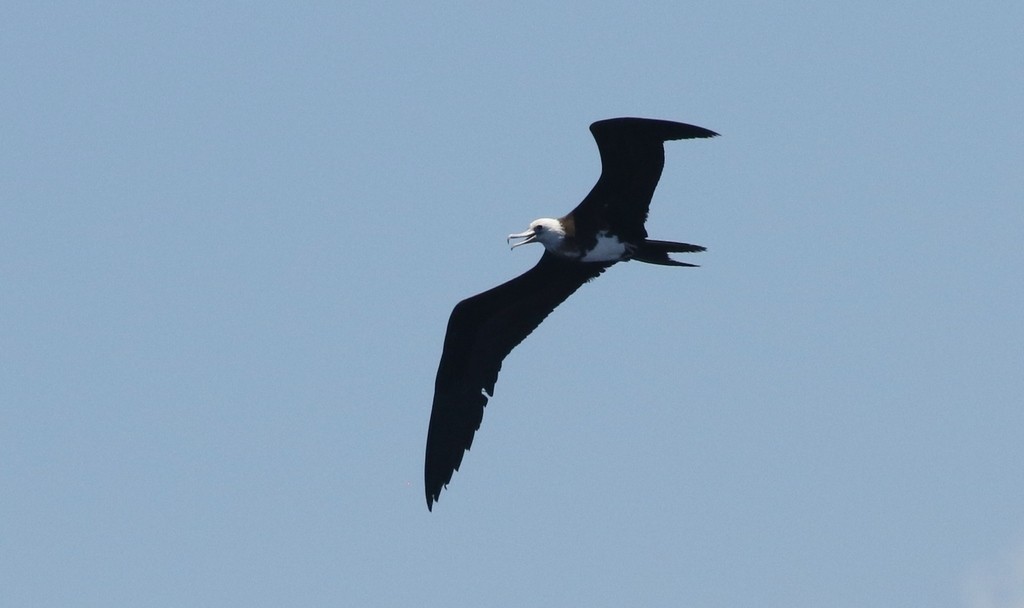Great Frigatebird
A species of Frigatebirds Scientific name : Fregata minor Genus : Frigatebirds
Great Frigatebird, A species of Frigatebirds
Botanical name: Fregata minor
Genus: Frigatebirds
Content
Description People often ask General Info
 Photo By silversea_starsong , used under CC-BY-NC-4.0 /Cropped and compressed from original
Photo By silversea_starsong , used under CC-BY-NC-4.0 /Cropped and compressed from original Description
The great frigatebird measures 85 to 105 cm (33 to 41 in) in length and has a wingspan of 205–230 cm (81–91 in). Male great frigatebirds are smaller than females, but the extent of the variation varies geographically. The male birds weigh 1,000–1,450 g (2.20–3.20 lb) while the heavier female birds weigh 1,215–1,590 g (2.679–3.505 lb). Frigatebirds have long narrow pointed wings and a long narrow deeply forked tail. They have the highest ratio of wing area to body mass and the lowest wing loading of any bird. This has been hypothesized to enable the birds to use marine thermals created by small differences between tropical air and water temperatures. The plumage of males is black with scapular feathers that have a green iridescence when they refract sunlight. Females are black with a white throat and breast and have a red eye ring. Juveniles are black with a rust-tinged white face, head, and throat. 
Size
94-97 cm (37-38 in)
Colors
Black
Green
Red
White
Life Expectancy
34 years
Nest Placement
Tree
Feeding Habits
Great Frigatebird predominantly feed on flying fish and squid, caught mid-flight or near the surface. They exploit predator-induced fish swarms and occasionally prey on seabird chicks. Although great Frigatebird practice kleptoparasitism, it's a minor dietary supplement rather than a mainstay.
Habitat
Great Frigatebird predominantly reside in tropical and subtropical oceanic regions. Their habitat includes small, remote islands where they breed in colonies, often nesting in mangroves like Rhizophora and Bruguiera, as well as in bushes such as Scaevola. Sometimes, they may nest on bare ground. These birds are pelagic, feeding in warm oceanic waters over 22°C, typically within 80 km of their nesting or roosting site. Despite their ability to venture far from their breeding grounds, great Frigatebird exhibit strong site fidelity, often returning to their natal colonies for breeding.
Dite type
Piscivorous
People often ask
General Info
Feeding Habits
Bird food type
Distribution Area
The great frigatebird has a wide distribution throughout the world's tropical seas. Hawaii is the northernmost extent of their range in the Pacific Ocean, with around 10,000 pairs nesting mostly in the Northwestern Hawaiian Islands. In the Central and South Pacific, colonies are found on most islands groups from Wake Island to the Galapagos to New Caledonia with a few pairs nesting on Australian possessions in the Coral Sea. Colonies are also found on numerous Indian Ocean islands including Aldabra, Christmas Island, the Maldives and Mauritius. The Atlantic population, restricted to Trindade and Martin Vaz, is very small. Great frigatebirds undertake regular migrations across their range, both regular trips and more infrequent widespread dispersals. Birds marked with wing tags on Tern Island in the French Frigate Shoals were found to regularly travel to Johnston Atoll (873 km), one was reported in Quezon City in the Philippines. One male great frigatebird relocated from Europa Island in the Mozambique Channel to the Maldives 4400 km away for four months, where it fed on rich fishing grounds. Despite their extended range, birds also exhibit philopatry, breeding in their natal colony even if they travel to other colonies. 
Species Status
Not globally threatened.
Scientific Classification
Phylum
Chordates Class
Birds Order
Gannets and Relatives Family
Frigatebirds Genus
Frigatebirds Species
Great Frigatebird